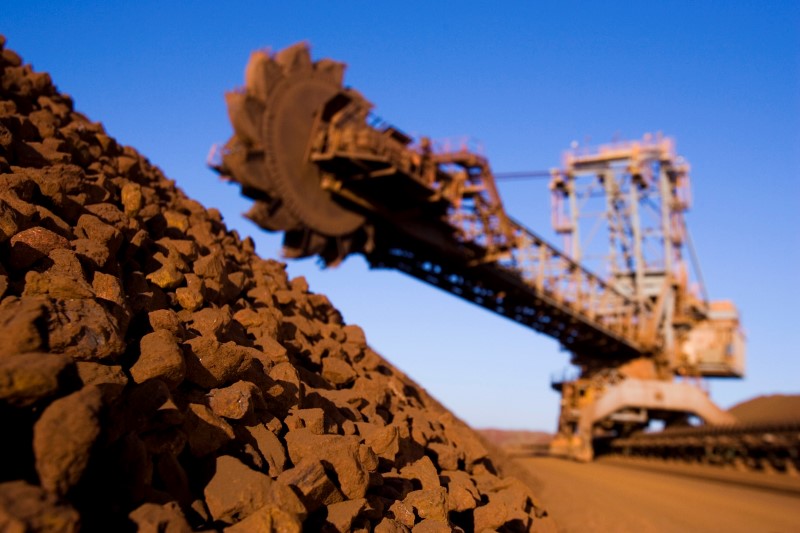(Repeats with no changes to text. The opinions expressed here are those of the author, a columnist for Reuters.)
By Clyde Russell
LAUNCESTON, Australia, Oct 12 (Reuters) - With spot Asian iron ore having fallen back below $60 a tonne, the price of the steelmaking ingredient appears to be heading toward a level more in line with supply and demand fundamentals.
However, as usual the risk when a rally reverses as quickly as the current decline in iron ore is that prices overshoot to the downside.
The Asian spot price .IO62-CNO=MB fell to $59.65 a tonne on Wednesday, the lowest level in 3-1/2 months and a drop of 25 percent since the recent peak of $79.65 in late August.
Iron ore is now well below the $78.87 it fetched at the end of 2016, and it is proving to be a volatile year, with two strong rallies being followed by sharp reversals.
Both the surge to the 2017-high of $94.86 a tonne in late February and the August-peak were driven by optimism over robust steel output in China, which buys about two-thirds of global seaborne iron ore shipments.
The latest drop in iron ore prices has come as some of the optimism over Chinese steel production and demand fades, especially in the light of ongoing mill closures as part of efforts to improve air quality ahead of the major conference of the ruling Communist Party, which starts on Oct. 18.
While prices have been volatile, China's import demand has been remarkably stable.
Imports for the first eight months of the year were 714 million tonnes, a gain of 6.7 percent from the same period last year, according to customs data.
While official numbers for September are yet to be released, vessel-tracking and port data compiled by Thomson Reuters suggest another steady month.
Seaborne iron ore imports were 87.2 million tonnes in September, slightly down from August's 88.6 million, according to the data.
The vessel-tracking data and the customs numbers don't tally exactly, given differences as to when cargoes are assessed as having been cleared. The ship data also doesn't account for imports that arrive via rail or truck from countries such as Mongolia.
There is the risk that iron ore imports may be somewhat lower in the last quarter of this year, given the expected closure of steel mills and China's ample port inventories, which rose to 133.8 million tonnes in the week to Oct. 6.
Inventories SH-TOT-IRONINV are lower than the record 141.4 million tonnes, reached in late June, but they are also well above the 114 million tonnes recorded at the end of 2016.
If iron ore demand is curtailed by curbs on steel production in the next few months, it should result in lower imports or a further build-up of port stocks, both of which should be bearish for prices.
POLLUTION CONTROLS
China's Ministry of Environmental Protection released a plan in August that outlined pollution abatement measures in 28 northern cities from October to March, and reports suggest that shutdowns of steel mills and other heavy industries such as aluminium smelting have already commenced. enforced curbs on steel raise the possibility that sentiment toward iron ore will be hit, driving the price below the $53.36 a tonne low so far this year, reached on June 13.
However, the futures curve of Singapore Exchange contracts 0#SZZF: , which are based on the Steel Index spot price, has been flattening as prices have declined since the recent August-peak.
The curve usually trades in backwardation, with front-month contracts commanding a premium over those dated further out.
The premium of the front-month contract over the six-month was $2.58 at the close on Wednesday, down from $3.71 on Aug. 21, the day prior to the start of the current slide in prices.
While not a huge shift in the structure of the curve, it does illustrate that the market probably believes the current reversal in prices is unlikely to become a rout.
There may be some justification in that thinking, although much will depend on the tone and substance of the upcoming policy meeting of China's rulers.
If it appears likely that the authorities will keep the infrastructure and construction spending pump primed in 2018, iron ore will likely get a boost along with other industrial commodities.
Certainly, China's steel industry is still relatively bullish, with the industry association expecting demand to rise 3-4 percent this year, and output to rise from 808 million tonnes in 2016 to 840 million this year. this optimism is retained going into 2018, it may make any drop in spot iron ore prices below $50 a tonne short-lived.
<^^^^^^^^^^^^^^^^^^^^^^^^^^^^^^^^^^^^^^^^^^^^^^^^^^^^^^^^^^^ GRAPHIC: China iron ore imports vs SGX price
http://reut.rs/2kJ4y1h
^^^^^^^^^^^^^^^^^^^^^^^^^^^^^^^^^^^^^^^^^^^^^^^^^^^^^^^^^^^> (Editing by Joseph Radford)
